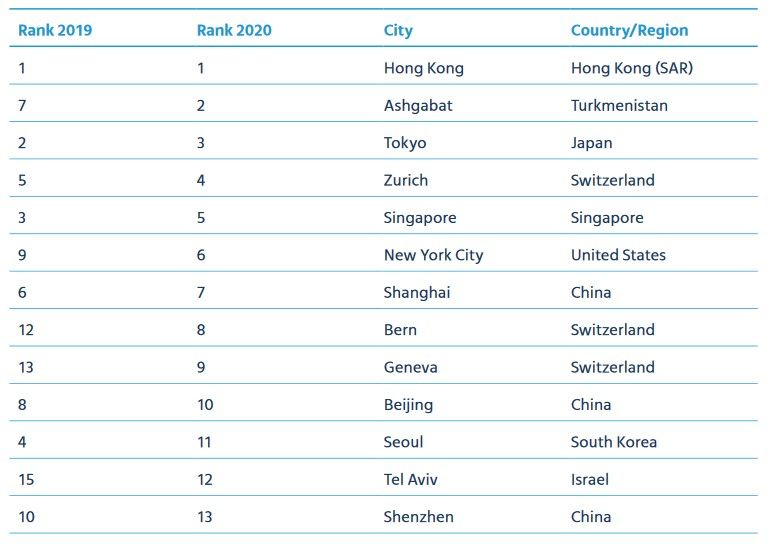Mercer’s 26th annual Cost of Living Survey reveals the world’s most expensive cities for overseas workers in 2020. In the wake of COVID-19, social and economic disruption has spurred organizations to reassess their global mobility programs with a focus on the well-being of their expatriate employees.
As they leverage new working arrangements, changing technology, and adaptive ways of thinking, they are considering alternate forms of international assignments in addition to traditional mobility programs to sustain their overseas operations and workforces.
Despite an appetite to grow and scale globally while navigating the uncharted waters of a health and economic crisis, reductions in staff and salaries as well as changes to benefit programs have challenged overseas expansion strategies. As organizations re-examine talent portfolios, mobility programs, and remuneration packages with a keen eye that balances empathy with economics, accurate and transparent data is essential to compensate fairly for all types of mobility assignments, taking into account changes resulting from the current pandemic and subsequent market volatility.
Mercer’s 26th annual Cost of Living Survey finds that specific factors such as currency fluctuations, cost inflation for goods and services, and instability of accommodation prices, are essential to determining the cost of expatriate packages for employees on international assignments.
“The COVID-19 pandemic reminds us that sending and keeping employees on international assignments is a huge responsibility and a difficult task to manage,” said Ilya Bonic, Career President and Head of Mercer Strategy. “Rather than bet on a dramatic resurgence of mobility, organizations should prepare for the redeployment of their mobile workforces, leading with empathy and understanding that not all expatriates will be ready or willing to go abroad.”
In the short-term, preparation for this new approach to global mobility may involve re-relocating assignees who have been repatriated. In the medium-term, the priority will be about realigning the mobile workforce with new economic models centered on shortened supply chains, more regional moves and a renewed need to train talent. In addition to these concerns, relevant information about the cost and location of assignments worldwide will be a critical factor post-crisis.
According to Mercer’s 2020 Cost of Living Survey, Hong Kong tops the list of most expensive cities for expatriates, followed by Ashgabat, Turkmenistan in the second position. Tokyo and Zurich remain in third and fourth positions, respectively, whereas Singapore is in fifth, down two places from last year. New York City ranked sixth, moving up from ninth place. Mercer’s data was collected in March; price variances in many locations were not significant due to the pandemic[1].
Other cities appearing in the top 10 of Mercer’s costliest cities for expatriates are Shanghai (7), Bern (8), Geneva (9), and Beijing (10). The world’s least expensive cities for expatriates, according to Mercer’s survey, are Tunis (209), Windhoek (208), Tashkent and Bishkek, which tied to rank 206.
Mercer’s widely recognized survey is one of the world’s most comprehensive, and is designed to help multinational companies and governments determine compensation strategies for their expatriate employees. New York City is used as the base city for all comparisons and currency movements are measured against the US dollar.

The Americas
While the global economic downturn took hold during the first part of the year, the strength of the dollar drove up costs for expatriates in US cities. As a result, cities in the United States have climbed in this year’s ranking of most costly cities. New York (6) is the highest-ranked city in the country followed by San Francisco (16) Los Angeles (17) Honolulu (28) and Chicago (30). Winston Salem, North Carolina (132) remains the least expensive US city surveyed for expatriates.
In South America, San Juan (66) ranks as the costliest city, followed by Port of Spain (73), San Jose (78) and Montevideo (88). Managua (198) is the least expensive city in South America. Caracas in Venezuela is excluded from the ranking due to the complex currency situation; its ranking would have varied greatly depending on the official exchange rate selected.
The Canadian dollar has appreciated in value, triggering jumps in this year’s ranking. Up eighteen places from last year, Vancouver (94) is the most expensive Canadian city in the ranking, followed by Toronto (98). Ranking 151, Ottawa is the least expensive city in Canada.
Europe, the Middle East, and Africa
Three European cities are among the top 10 list of most expensive locations. At number four in the global ranking, Zurich remains the most costly European city, followed by Bern (8), up four spots from last year. The next European city in the ranking, Geneva (9), is up four places from last year.
Despite some low price increases across the region, several local currencies in Europe have weakened against the US dollar, pushing many cities down in the ranking. As France and Italy’s economies shrank at the end of 2019, Eurozone growth came close to zero. Yet, there are no signs of crisis when it comes to inflation in any of the leading EU countries. The region saw cities like Paris (50), Milan (47) and Frankfurt (76) drop in this year’s ranking.
A decision by the United Kingdom to leave the European Union has not impacted its local currency which remains strong, gaining value to all major global currencies. London (19), Birmingham (129), and Belfast (149) jumped four, six, and nine places, respectively.
The United Arab Emirates continues to diversify the economy, subsequently reducing the impact of oil industry on GDP. With this ongoing process, there has been a negative price movement in both Dubai and Abu Dhabi. Just like UEA, Saudi Arabia is seeking to limit the impact of oil exports and move to a more diversified economic model. Prices have remained stable over the course of the last six months; however, with the upcoming value-added tax increase there is an expectation to see prices change. Tel Aviv (12) continues to be the most expensive city in the Middle East for expatriates, followed by Dubai (23), Riyadh (31), and Abu Dhabi (39). Cairo (126) remains the least expensive city in the region despite rising forty places.
Ndjamena, Chad (15) is the highest-ranked city in Africa while Tunis (209) in Tunisia ranks as the least expensive city in the region and globally.
Asia Pacific
Six of the top 10 cities in this year’s ranking are in Asia. Hong Kong (1) retained its spot as the most expensive city for expatriates both in Asia and globally due to currency movements measured against the US dollar and driving up the cost of living locally. This global financial center is followed by Ashgabat (2) Tokyo (3) Singapore (5) Shanghai (7) and Beijing (10). Mumbai (60) is India’s most expensive city while Kolkata (185) is the least expensive Indian city ranked.
Australian cities have fallen in the ranking this year as the local currency has depreciated against the US dollar. Sydney (66), Australia’s most expensive ranked city for expatriates, experienced a drop of sixteen places. The least expensive city in the region, Adelaide fell seventeen places to rank 126.
For the full rankings, click here













